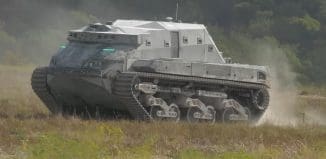UGVs Are Definite Game Changer
This post is also available in:  עברית (Hebrew)
עברית (Hebrew)
The range of possibilities with military robots is immense and will very likely be one of the major changes in the art of warfare in the future. Unmanned ground vehicles (UGVs) are a definite game changer that greatly enhance the capabilities of armed forces. This is the evaluation of an international assemble of scholars elaborated in the Digital Infantry Battlefield Solution (DIBS) publication.
The three-piece study was written by military and academic research experts and addresses the employment of UGVs in support of land operations. It was initiated by Milrem Robotics who together with partners demonstrated the capabilities and cooperation between unmanned systems during EW Live 2019 held in Tartu, Estonia.
“Using the integration of unmanned ground and aerial systems to identify and engage targets reduces the risk to soldiers who can stay in a safe distance,” explained Kuldar Väärsi, CEO of Milrem Robotics. “Also, it increases the efficiency and firepower of small units significantly.”
For example, UGVs would be crucial casualty evacuation tools. “In an incident involving two casualties requiring extraction, ten personnel would normally be utilized. To mitigate against this, a THeMIS transport platform could be set remotely for pre-designated waypoints and can carry at least two casualties, and at a much higher pace of extraction than by foot. Not only does this potentially result in a casualty being extracted much quicker to receive treatment, it additionally frees up vital manpower during the battle.”
The third part of the report provides an analysis of the EU initiatives aimed at the digitalization of the battlefield through research and innovation and offers a comprehensive assessment of the defense research and innovation ecosystem in the Baltics. The second part of the book considers the development of UGVs in Canada, France, Germany, the United Arab Emirates and the United Kingdom.
DIBS is a result of collaboration between the Baltic Defence College, DRDC-CORA, General Tadeusz Kościuszko Military Academy of Land Forces (Poland), Latvian Institute of International Affairs, Latvian National Defence Academy, Military University of Technology (Poland), Rīga Stradiņš University and War Studies University (Poland).






























